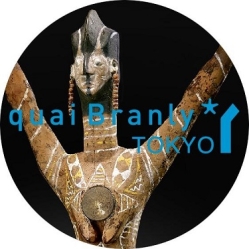Quai Branly Tokyo – “Wild Eyes – Creative Thinking Directed Toward Personification”

Details
| Type | Exhibition |
|---|---|
| Intended for | General public / Enrolled students / Applying students / International students / Alumni / Companies / Elementary school students / Junior high school students / High school students / University students |
| Date(s) | January 23, 2018 — January 14, 2019 |
| Location | Other campuses/off-campus |
| Venue | Intermediatheque 2F [SPECOLA] [Address] KITTE 2-3F, 2-7-2 Marunouchi, Chiyoda-ku, Tokyo, JAPAN [Access] JR lines and Tokyo Metro Marunouchi line Tokyo Station. Direct access from the Marunouchi Underground Pathway. [Opening Hours] 11:00 - 18:00 (Open until 20:00 on Fridays and Saturdays) Last admission 30 minutes before closing. *Opening hours may change. [Closed on] Mondays (or the following Tuesday if Monday is a National Holiday) and Year-end holidays. May close irregularly. |
| Entrance Fee | No charge |
| Registration Method | No advance registration required |
| Contact | +81 3 5777 8600 (Hello Dial) |
The sixth installation of Quai Branly Tokyo consists of anthropomorphic wooden sculptures from Nigeria.
-----
Through the rhetorical technique known as personification, various phenomena which can hardly be given shape, such as natural events or intellectual concepts, are attributed a human form. In the proto-paintings of the prehistoric ages such as cave paintings, animals are rendered realistically. Therefore, formal expressions resorting to personification and ornamentation are the attribute, not of the preliminary stages of a civilization, but rather of a mature human intelligence. The anthropomorphist world view in ancient Greece where all invisible things were shown personified – such as Hermes embodying knowledge, Chronos time, Aphrodite love and beauty – was the product of a high level of civilization, far away from imitative realism. What to think then of the wooden sculptures found in 20th-century Nigeria, in West Africa? According to old Western-centrist aesthetic standards, these works were branded as so-called “primitive art.” In reality, these non-standard wooden forms perpetuate sophisticated intellectual systems through oral transmission. It was surrealism in the 20th century that discovered in African “tribal art” the radiance proper to these wild eyes unknown to Westerners.
Yoshiaki Nishino
Director, Intermediatheque
-----
Sculptures from the Benue River and the Igbo Land
Nigeria, one of the largest countries in Africa, is the land of countless cultures, some of which have a history known over several centuries. One of its large cultural ensembles, rich in sculpture, is located in the southeast region covering the Benue Valley and the zone where the Niger river flows into the ocean, forming a delta. The Benue river, a tributary of the Niger river, is home to an important production of anthropomorphic sculpted images related to the protection of communities and individuals. These ritual figures follow styles as varied as the multitude of villages forming, like a mosaic, the human landscape constituted by the different populations. A large number of zoomorphic masks, generally signifying the presence of aquatic spirits in this region with many watercourses, are taken out according to the agrarian calendar, especially to celebrate harvests.
Yves Le Fur
Director of the Department of Heritage and Collections, Musée du quai Branly - Jacques Chirac
Curated by Yves Le Fur (Director of the Department of Heritage and Collections, Musée du quai Branly - Jacques Chirac)
With the support of Mr. Christian Polak + K.K. SERIC
-----
About Quai Branly Tokyo
Opportunities are rare in Japan to experience the startling diversity of the bold and enigmatic forms produced by civilizations throughout the world. This thematic presentation of masterpieces selected from the collections of the musée du quai Branly - Jacques Chirac in Paris, addressing the major preoccupations of humankind in resonance and in confrontation with the University of Tokyo collections, is the place for such an encounter. This perennial embassy of a French national museum in the heart of Tokyo emanates from a cultural and scientific collaboration of a new kind between the musée du quai Branly - Jacques Chirac and the Intermediatheque: a selection of emblematic items from Africa, Asia, Oceania, and the Americas will be regularly exhibited to the Japanese public, prompting a conversion of our worldview. Resolutely working at the crossroads of all cultures, periods and domains, both institutions share a novel approach to interdisciplinary museum activities.
Organized by The University Museum, The University of Tokyo (UMUT) + Musée du quai Branly - Jacques Chirac
With the support of Mr. Christian Polak + K.K. SERIC
The musée du quai Branly - Jacques Chirac
The musée du quai Branly - Jacques Chirac, which opened its doors in Paris in June 2006, emanates from the Pavillon des Sessions rooms at the Louvre Museum, featuring the arts of Africa, Asia, Oceania and the Americas. At the initiative of Jacques Chirac, president of the French Republic from 1995 to 2007, and built by 2008 Pritzker prize-winning architect Jean Nouvel, the musée du quai Branly - Jacques Chirac is committed to giving the Arts and Civilizations of Africa, Asia, Oceania, and the Americas the place they deserve at the intersection of multiple cultural, religious, and historical influences. Located along the Seine at the foot of the Eiffel Tower, the museum defines itself as a place of scientific and artistic dialogue, a crossroads of exchange between the public, researchers, students, and contemporary artists. Throughout the year, exhibitions, concerts, shows, conferences, workshops, and screenings set the pace of life at the museum.
Quai Branly - Jacques Chirac official HP

© musée du quai Branly - Jacques Chirac, photo Claude Germain







